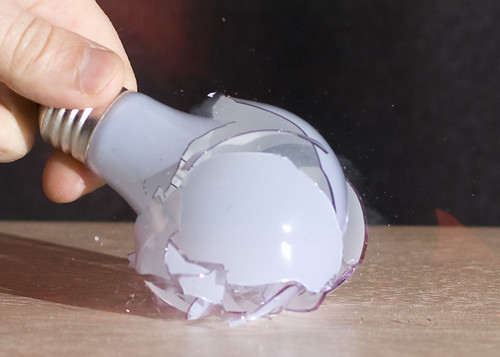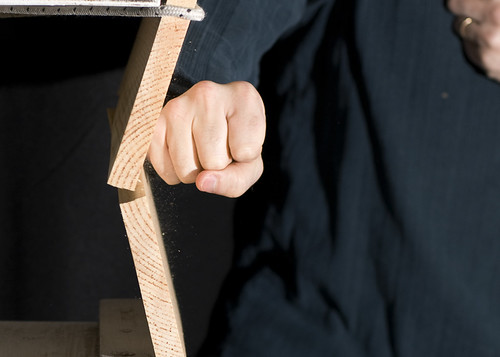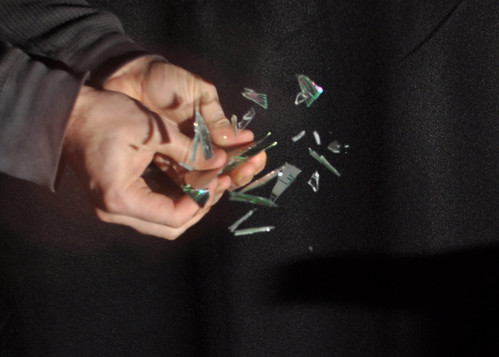skip to main |
skip to sidebar
 As a kid,
As a kid,
I loved pictures of things that happened too fast for the human eye to see. The beating of a hummingbirds wings frozen in time or the classic bullet slicing through a playing card photo always fascinated me.
When I started looking around...
at how to make such images, I found enough information to build something called a "sound trigger" This is a little electronic circuit that can fire a camera flash in a dark room when triggered by a sharp sound. Snap your fingers and the flash fires. Pretty neat!

Building the kit was fairly straight forward, but hooking it to the flash was not. I jury-rigged a hot shoe, of sorts, with some aluminum and speaker wire. It was crude, but it worked.
Now for the set up:
In order for this to work, you need a dark room and a remote shutter release. I set up in the garage with my camera on a tripod pointed at a board about 3 feet away. The camera was set to a 3-second exposure at f/4.5 and ISO 200 (manual focus of course). I turned off the lights and made my way back to the board where the camera was aiming using a flashlight. Here's the sequence of events:
- Grab an object to be broken (a CD, a light bulb etc...)
- Turn off the flashlight
- Remote trigger the shutter
- Break the object
- Wait for the shutter to close
- See what you got!
- Repeat
Because the flash...
fires so fast (about 1/10,000 of a second!) and the room is dark, the camera's sensor is able to capture the action at that speed. Its a pretty simple concept that can work with any camera with manual mode and a remote trigger.

It took a while to catch the action at just the right moment to make an interesting photo. To adjust when the flash fires, I needed to move the sound trigger either closer or farther from the breaking object. Sound take time to travel.
Another issue...
is that sometimes the falling pieces are loud enough to re-trip the flash and give you a double exposure. I found I had to time it so the shutter would close right after the object broke.
In the end I learned a great deal about this type of photography *and* got some pretty good images too! These are among my most popular on Flickr.
Give it a try! You might find its like being a kid again!
Further reading:
Sound Triggers
Flickr High Speed Group
Some Awesome Shots
 Do you remember film?
Do you remember film?
In the years before digital cameras became so prevalent, the *only* way to capture an image was to shoot it on film. The canister was sold for a few bucks and held enough to expose a maximum of 36 exposures. Once shot, the film was rewound back into the metal canister and dropped off at the local store for developing. Wolf Camera, Costco, and Longs Drugs were among the many who offered 1-hour processing for standard 4x6" prints.
As digital imaging became affordable and the quality increased, film began to disappear. The LCD screen on the back of the camera gave us instant gratification. It also showed us that we had the right exposure, lighting and composition. Film began to fade away. Now the thought of waiting a hour to "see your shots" seems silly!
The other day,
I saw something that made me smile once again. I was shopping with my daughters at one of these kitchy clothing stores and noticed a display of Holga and Lomo film cameras. The boxes touted the surreal effect offered by the plastic lenses. These cameras actually looked *cool* I was impressed, very impressed.
There are many Flickr groups dedicated to film imagery. Among those worth checking out are the following:
So,
If you are looking for a new direction to take your art, or wish to revisit the depth that this old media offers, try film. Its worth a shot ;)
 Normally, we define street shooting as candid photography out on the busy street. Either you, as the photographer move, or people, as the subjects, move. In general, longer lenses work best, as you can get candid shots of your subject from afar without being noticed. This assignment was a bit different; It involved shooting in close quarters at a local Dim Sum restaurant. We had invited my wife's parents along to enjoy the meal.
Normally, we define street shooting as candid photography out on the busy street. Either you, as the photographer move, or people, as the subjects, move. In general, longer lenses work best, as you can get candid shots of your subject from afar without being noticed. This assignment was a bit different; It involved shooting in close quarters at a local Dim Sum restaurant. We had invited my wife's parents along to enjoy the meal.
Dim Sum, for those of you who've not had the pleasure, consists of many small dishes served from carts that pass by each table. Each server asks if there is anything that you'd like, and then gives your the dish and adds it to your bill. Its like a moving parade of delectable Asian food. All you have to do is point and eat!
I stripped down my camera by removing the battery grip and using the shortest lens I have (Nikon 50mm f/1.4). I didn't bring a camera bag so as not to attract attention. I sat with the camera strap over my lap so the camera was hidden from view.
Luckily we were seated near a window and the overcast winter's day made the light wonderfully soft as it streamed in to the second story window.
I noticed that some of the servers were middle aged, their faces showed the character that the years of life brings. Carefully I raised my camera to my eye and began shooting.
No one seemed to mind as sat and pointed the lens in their general direction. It was refreshing for a change. Some of the servers even stopped to pose graciously as I snapped a few images and calmly put the camera back under the table.

I ended up with a few nice pictures that captured the whole experience. Imagine what else you could capture if you dare to bring your camera along. Don't be afraid to try something new. You may end up being surprised!
 What is HDR?In order to compensate for image sensor limitations, photographers often combine several images to create a more realistic looking image. In the shot below, I combined 5 images to produce something close to what my eye sees when I look at this house at night.Why Do it?The human eye can see about 24 "stops" of dynamic range. Think of each "stop" as a doubling of the amount of light that our brain registers. When you look our the window on a sunny day, you can see the detail in the brightest objects as well as the detail in the darkest of shadows. 35 mm Film is able to capture about 14 stops of dynamic range. Even the best digital cameras can only capture about 11 stops which means that your fancy new DSLR is still lacking. Fear not, technology is constantly improving, and low light sensitivity is one area in which manufacturers can compete. In-camera HDR processing is already making its way to the market!An ExampleIn the following picture, I exposed the sensor using 2 stops under the metered reading so as not to blow out the highlights in the image. As you can see, the shadows are completely void of detail.
What is HDR?In order to compensate for image sensor limitations, photographers often combine several images to create a more realistic looking image. In the shot below, I combined 5 images to produce something close to what my eye sees when I look at this house at night.Why Do it?The human eye can see about 24 "stops" of dynamic range. Think of each "stop" as a doubling of the amount of light that our brain registers. When you look our the window on a sunny day, you can see the detail in the brightest objects as well as the detail in the darkest of shadows. 35 mm Film is able to capture about 14 stops of dynamic range. Even the best digital cameras can only capture about 11 stops which means that your fancy new DSLR is still lacking. Fear not, technology is constantly improving, and low light sensitivity is one area in which manufacturers can compete. In-camera HDR processing is already making its way to the market!An ExampleIn the following picture, I exposed the sensor using 2 stops under the metered reading so as not to blow out the highlights in the image. As you can see, the shadows are completely void of detail. In this next image, I exposed the sensor 2 stops over the metered value to capture as much detail in the shadows as possible. Notice that the highlights are completely blown out, lacking any detail.
In this next image, I exposed the sensor 2 stops over the metered value to capture as much detail in the shadows as possible. Notice that the highlights are completely blown out, lacking any detail. Using Photoshop CS4, I was able to merge the 5 images (-2, -1, 0, +1, +2 stops) into one 32-bit image, which captured all the detail in both the highlights and the shadows.So...?Most images we see on the web have a bit depth of only 8 bits. Converting the 32 bit HDR down to an 8 bit image gives us some control over the relative brightness of highlights and shadows. This is where the magic happens. In the screen shot below, you see the histogram (a graphical way of showing how many pixels are in which brightness ranges) Clicking and dragging on the line over the histogram allows you to adjust the brightness of each particular range.The goal hereis to get the final image to show detail in the shadows without loosing the detail in the highlights. I want to see the sky, the street, and the Christmas lights, just like what my eye sees. Like most things in Photoshop, just grab the handle and drag it until it looks bad, then back off until it looks good.
Using Photoshop CS4, I was able to merge the 5 images (-2, -1, 0, +1, +2 stops) into one 32-bit image, which captured all the detail in both the highlights and the shadows.So...?Most images we see on the web have a bit depth of only 8 bits. Converting the 32 bit HDR down to an 8 bit image gives us some control over the relative brightness of highlights and shadows. This is where the magic happens. In the screen shot below, you see the histogram (a graphical way of showing how many pixels are in which brightness ranges) Clicking and dragging on the line over the histogram allows you to adjust the brightness of each particular range.The goal hereis to get the final image to show detail in the shadows without loosing the detail in the highlights. I want to see the sky, the street, and the Christmas lights, just like what my eye sees. Like most things in Photoshop, just grab the handle and drag it until it looks bad, then back off until it looks good. The final image shows enough detail to look realistic without being over done. For more reading on this subject, see Trey Ratcliff's excellent tutorial.A couple of final notes here: This image was created completely inside of Photoshop using the 32 to 8 bit conversion. The technique is the same in CS3 and CS4.
The final image shows enough detail to look realistic without being over done. For more reading on this subject, see Trey Ratcliff's excellent tutorial.A couple of final notes here: This image was created completely inside of Photoshop using the 32 to 8 bit conversion. The technique is the same in CS3 and CS4.
 Oftentimes, timing is everything...
Oftentimes, timing is everything...
in making a good image. You've seen shots where the artist captured the moment just at the right instant to tell a particular story. Such is the case with this image crafted by my wife on a beach trip a few years back.
In this shot,
we see a young child, my daughter, about to hit a beach ball into the ocean; Her wet hand reflects the sunlight drawing attention and explaining her stance. Her sister looks away adding a bit of mystery to the image.
My wife has a good eye,
and often just looks through the viewfinder, waiting for the precise moment to press the shutter. This time it payed off!
So the next time
you see your child doing something fun, or the light is just right as your cat lounges, try viewing the scene through your viewfinder for a while. Anticipate the actions and press the shutter. If your timing is right, you may just be surprised at what you capture!
 When you look at this shot what do you see?
When you look at this shot what do you see?
The rustic fence's strong lines draw the viewer naturally down the path. The bright patch in the clearing serves as a destination for the eye that makes this photo somewhat pleasing. Overall its not a bad journey. It evokes a calm and peaceful feeling as well.
Now, What would make this a better shot?
Placing a model at the end of the road would certainly help, but there are a few considerations first.
- What she's wearing can either make her stand out or loose her to the background. A tan coat would be a poor choice with the colors in the clearing.
- Stance goes a long way in creating a feeling. Should she be coming to greet you or walking away? Should she stand stable and confident, or a bit tentative and unsure?
- Using a prop can help tell the story. In this example, a brightly colored umbrella would serve to attract the viewers attention. The way in which the umbrella can say a great deal as well. If she holds it askew it evokes a tentative feel. Imagine a tightrope walker with an umbrella in one hand and an out stretched arm to keep balance.
With these in mind, have a good look at the image below:
 You can see...In this simple example how adding a model adds so much more to an image. It tells a story for the viewer and evokes feelings not present in the original image.So...The next time you raise the camera to your eye, think of how adding the human element could tell yet another story.Enjoy!
You can see...In this simple example how adding a model adds so much more to an image. It tells a story for the viewer and evokes feelings not present in the original image.So...The next time you raise the camera to your eye, think of how adding the human element could tell yet another story.Enjoy!
 One event,
One event,
two stunning models, three wardrobe changes, six professional lights and... 100 Bay Area photographers... made for a great way to spend a Monday evening!
The event was sponsored by SmugMug, Peachpit publishing, BorrowLenses.com, and Eye-Fi, each donating time, personnel, and products that made for a successful shoot.
Arriving early,
gave me a chance to meet the sponsors, greet the models and make-up artist, and help set up some of the lighting. Little by little the group began trickling in and, when it reached "critical mass", our TWiP (This Week in Photography Podcast) host Frederick Van Johnson, began the introductions.
Each model took her place and started taking direction from photographers one by one. One of the studio sets used a Pro-photo lighting trigger similar to the pocket wizard, but with the ability to adjust the intensity from the hot-shoe mounted transmitter. Pretty convenient and so easy to dial it in. The only way to go with all the various camera brands in the room!
Continuous tungsten lighting
on the other set made for an excellent way to see how the lighting would look on each model without firing test shots. True WYSIWYG at its best. The soft boxes did a good job at keeping the talent cool.
Overall, the participants were cordial
and respectful of the subjects. Few took the time to actually direct: "Turn away slightly, chin forward, half smile, look up okay...". Later on the models stated they liked being directed. It gave them a chance to see what the photographer was after.
 It must have been daunting
It must have been daunting
for the models: posing for two hours in front of a hundred photographers. (I wished they would have played "Paparazzi" by Lady GaGa.) One commented that her cheeks began to hurt from smiling so much. Poor thing!
The mood was electrifying:
Flashes popping every second, hundreds of cameras, and really good talent in the room made for some exquisite imagery. Passers-by asked what all the commotion was. One even thought that there were movie stars in the room!
 It all ended too soon. Before I knew it, we switched off the lights, folded up the backdrops, and said goodbye to our new friends. Not bad for a Monday night!
It all ended too soon. Before I knew it, we switched off the lights, folded up the backdrops, and said goodbye to our new friends. Not bad for a Monday night!



















